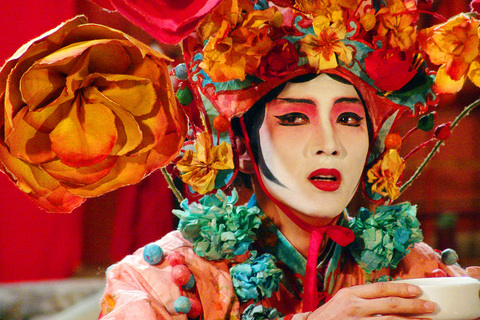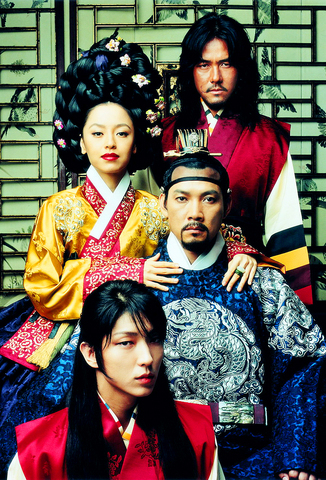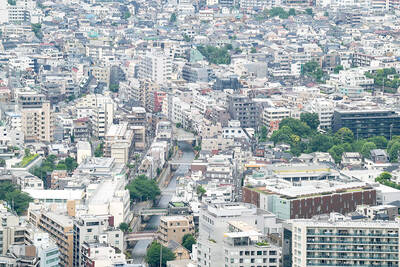Last year in December, the South Korean film industry was taken by storm by the relatively low-budget period drama King and the Clown, which lacked major stars and had a strong gay subtext, both normally big no-nos for any potential blockbuster. But despite breaking the rules, King and the Clown has become the most popular film ever made in South Korea, and has been seen by more than 12 million people, or one in four of the nation's residents. It is seen by many as South Korea's Brokeback Mountain, to which the film has been loosely compared, and has turned into a cultural phenomenon that fuelled heated discussions on how a homophobic society like South Korea can embrace a film centering on a gay love triangle among two male clowns and an amorous king.
Based on the historical figure King Yon-san, notorious for his ruthlessness, the film is set in the Chosun Dynasty of the 16th century, and evolves around a pair of itinerant clowns who perform comic plays and acrobatic tricks. Masculine and free-spirited, Jang-seng (Karm Woo-sung) takes the beautiful, feminine-looking Gong-gil (Lee Joon-gi) under his wing. Together the two arrive in the capital Seoul and enjoy a meteoric rise to fame performing a skit that satirizes King Yon-san and his concubine Nok-soo.
However, the itinerant clowns quickly find themselves in fetters in front of the king, who is amused by their lewd parody and makes them court jesters. Their satirical plays about corruption among courtiers and related to the conspiracy leading to the death of the king's mother, prompts the monarch to act against those responsible.

Nok-soo, on the other hand, is filled with jealousy as the king becomes enamored with Gong-gil and plots a scheme of her own. In the climax, Jang-seng sacrifices himself for love and shows to the court how the lowest of the low possess a freedom and liberty that aristocrats can never attain.
The film is visually plain and lacks cinematic sophistication. Its strength lies in the good casting and solid script that offers an engaging take on a subject matter that is rarely addressed in South Korea.
The discourse on homosexuality in the film is somewhat confused, and even the director has been unwilling to categorize the film as gay-oriented. Lee's approach to physical displays of affection is tame, and the romantic or physical aspect of the relationships are never explicitly revealed.

Moreover, as the love triangle is centered on the feminine male clown who can readily pass as a woman, it has been suggested that the relationship is not gay at all.
Lee Joon-gi, the androgynous young star who has become an instant sensation, especially among teenage girls, is skillfully portrayed as an incarnation of feminine beauty, and this has eased the film's breakthrough into the mainstream.

PHOTOS COURTESY OF GROUP POWER

The canonical shot of an East Asian city is a night skyline studded with towering apartment and office buildings, bright with neon and plastic signage, a landscape of energy and modernity. Another classic image is the same city seen from above, in which identical apartment towers march across the city, spilling out over nearby geography, like stylized soldiers colonizing new territory in a board game. Densely populated dynamic conurbations of money, technological innovation and convenience, it is hard to see the cities of East Asia as what they truly are: necropolises. Why is this? The East Asian development model, with

Desperate dads meet in car parks to exchange packets; exhausted parents slip it into their kids’ drinks; families wait months for prescriptions buy it “off label.” But is it worth the risk? “The first time I gave him a gummy, I thought, ‘Oh my God, have I killed him?’ He just passed out in front of the TV. That never happens.” Jen remembers giving her son, David, six, melatonin to help him sleep. She got them from a friend, a pediatrician who gave them to her own child. “It was sort of hilarious. She had half a tub of gummies,

The wide-screen spectacle of Formula One gets a gleaming, rip-roaring workout in Joseph Kosinski’s F1, a fine-tuned machine of a movie that, in its most riveting racing scenes, approaches a kind of high-speed splendor. Kosinski, who last endeavored to put moviegoers in the seat of a fighter jet in Top Gun: Maverick, has moved to the open cockpits of Formula One with much the same affection, if not outright need, for speed. A lot of the same team is back. Jerry Bruckheimer produces. Ehren Kruger, a co-writer on Maverick, takes sole credit here. Hans Zimmer, a co-composer previously, supplies the thumping

There is an old British curse, “may you live in interesting times,” passed off as ancient Chinese wisdom to make it sound more exotic and profound. We are living in interesting times. From US President Donald Trump’s decision on American tariffs, to how the recalls will play out, to uncertainty about how events are evolving in China, we can do nothing more than wait with bated breath. At the cusp of potentially momentous change, it is a good time to take stock of the current state of Taiwan’s political parties. As things stand, all three major parties are struggling. For our examination of the